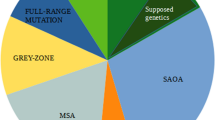Abstract
Background
An increasing number of dominant and recessive disorders have been associated with late onset chronic progressive ataxia (LOCA) complicating the formulation of a rational diagnostic strategy. Furthermore, there is marked geographic and ethnic variation in the relative importance of these individual disorders and the cause of such observed variation remains unexplained.
Methods
We have systematically investigated a populationbased cohort of patients with chronic progressive LOCA for SCA 1,2,3,6,7,8,10,12,17, FXTAS and FRDA. In addition we have examined repeat length polymorphism in chromosomes from a genetically homogeneous and representative control population to investigate the association of high-normal repeats and disease prevalence.
Results
A total of 178 patients including 55 familial cases segregating in 38 kindreds and 123 sporadic were investigated. Pathological expansions were identified in 11/38 (28.9 %) of families and in 5/123 (4.1 %) of sporadic patients. The most frequent diagnoses were SCA6 (6 families and 1 sporadic patient), DRPLA (4 families) and SCA8 (1 family). In addition, one elderly female patient was identified with “possible FXTAS”. Six (2 %) control patients were noted to have expanded SCA8 alleles.
Conclusions
SCA6 and DRPLA were the most frequent genetic diagnoses identified. Patterns of highnormal allele frequency in this UK population were distinct compared to other ethnic groups but this was poorly predictive of the distribution of disease in this region. The relative contribution of new mutation formation and founder effects to the prevalence of familial ataxia is uncertain, and further exploration of these factors will require detailed analysis of disease allele haplotypes and meiotic instability of intermediate length alleles.
Similar content being viewed by others
References
Brussino A, Gellera C, Saluto A, et al.(2005) FMR1 gene premutation is afrequent genetic cause of late-onsetsporadic cerebellar ataxia. Neurology64:145–147
Ciotti P, Maria ED, Bellone E, et al.(2004) Triplet repeat primed PCR (TPPCR) in molecular diagnostic testingfor Friedreich ataxia. J Mol Diagn6:285–289
Giunti P, Sabbadini G, Sweeney MG,et al. (1998) The role of the SCA2 trinucleotiderepeat expansion in 89 autosomaldominant cerebellar ataxiafamilies. Frequency, clinical and geneticcorrelates. Brain 121:459–467
Hadjivassiliou M, Grunewald R,Sharrack B, et al. (2003) Gluten ataxia inperspective: epidemiology, genetic susceptibilityand clinical characteristics.Brain 126:685–691
Hagerman PJ, Hagerman RJ (2004) Thefragile-X premutation: a maturing perspective.Am J Hum Genet 74:805–816
Hagerman RJ, Leehey M, Heinrichs W,et al. (2001) Intention tremor, parkinsonism,and generalized brain atrophyin male carriers of fragile X. Neurology57:127–130
Ikeda Y, Dalton JC, Moseley ML, et al.(2004) Spinocerebellar ataxia type 8:molecular genetic comparisons andhaplotype analysis of 37 families withataxia. Am J Hum Genet 75:3–16
Imbert G, Kretz C, Johnson K, et al.(1993) Origin of the expansion mutationin myotonic dystrophy. Nat Genet4:72–76
Juvonen V, Hietala M, Kairisto V, et al.(2005) The occurrence of dominantspinocerebellar ataxias among 251Finnish ataxia patients and the role ofpredisposing large normal alleles in agenetically isolated population. ActaNeurol Scand 111:154–162
Leggo J, Dalton A, Morrison P, et al.(1997) Analysis of spinocerebellarataxia types 1, 2, 3, and 6, dentatorubralpallidoluysianatrophy, and Friedreich’sataxia genes in spinocerebellar ataxiapatients in the UK. J Med Genet 34:982–985
Majounie E, Wardle M, Muzaimi M, et al.(2007) Case control analysis of repeatexpansion size in ataxia. Neurosci Lett429:28–32
Maruyama H, Izumi Y, Morino H, et al.(2002) Difference in disease-free survivalcurve and regional distributionaccording to subtype of spinocerebellarataxia: a study of 1,286 Japanese patients.Am J Med Genet 114:578–583
Nagaoka U, Suzuki Y, Kawanami T, et al.(1999) Regional differences in geneticsubgroup frequency in hereditary cerebellarataxia, and a morpho-metricalstudy of brain MR images in SCA1, MJDand SCA6. J Neurol Sci 164:187–194
Onodera Y, Aoki M, Tsuda T, et al. (2000)High prevalence of spinocerebellarataxia type 1 (SCA1) in an isolatedregion of Japan. J Neurol Sci 178:153–158
Pujana MA, Corral J, Gratacòs M, et al.(1999) Spinocerebellar ataxias inSpanish patients: genetic analysis offamilial and sporadic cases. The AtaxiaStudy Group. Hum Genet 104:516–522
R Development Core Team (2007) R: ALanguage and Environment for StatisticalComputing. R Foundation for StatisticalComputing, Vienna, Austria. ISBN3-900051-07-0
Saleem Q, Choudhry S, Mukerji M, et al.(2000) Molecular analysis of autosomaldominant hereditary ataxias in theIndian population: high frequency ofSCA2 and evidence for a commonfounder mutation. Hum Genet 106:179–187
Schols L, Szymanski S, Peters S, et al.(2000) Genetic background of apparentlyidiopathic sporadic cerebellarataxia. Hum Genet 107:132–137
Silveira I, Miranda C, Guimarães L, et al.(2002) Trinucleotide repeats in 202families with ataxia: a small expanded(CAG)n allele at the SCA17 locus. ArchNeurol 59:623–629
Squitieri F, Andrew SE, Goldberg YP,et al. (1994) DNA haplotype analysis ofHuntington disease reveals clues to theorigins and mechanisms of CAG expansionand reasons for geographic variationsof prevalence. Hum Mol Genet3:2103–2114
Stevanin G, Herman A, Dürr A, et al.(2000) Are (CTG)n expansions at theSCA8 locus rare polymorphisms? NatGenet 24:213
Takano H, Cancel G, Ikeuchi T, et al.(1998) Close associations betweenprevalences of dominantly inheritedspinocerebellar ataxias with CAG-repeatexpansions and frequencies of largenormal CAG alleles in Japanese andCaucasian populations. Am J HumGenet 63:1060–1066
Van Esch H, Dom R, Bex D, et al. (2005)Screening for FMR-1 premutations in122 older Flemish males presentingwith ataxia. Eur J Hum Genet 13:121–123
Wardle M, Majounie E, Williams N, et al.(2007) Dentatorubral pallidoluysianatrophy in South Wales. J Neurol NeurosurgPsychiatry. Published Online First:26 October 2007. doi:10.1136/jnnp.2007.128074
Watanabe H, Tanaka F, Matsumoto M,et al. (1998) Frequency analysis of autosomaldominant cerebellar ataxias inJapanese patients and clinical characterizationof spinocerebellar ataxia type6. Clin Genet 53:13–19
Worth PF, Houlden H, Giunti P, et al.(2000) Large, expanded repeats in SCA8are not confined to patients with cerebellarataxia. Nat Genet 24:214–215
Author information
Authors and Affiliations
Corresponding author
Electronic Supplementary Material
Rights and permissions
About this article
Cite this article
Wardle, M., Majounie, E., Muzaimi, M.B. et al. The genetic aetiology of late-onset chronic progressive cerebellar ataxia. J Neurol 256, 343–348 (2009). https://doi.org/10.1007/s00415-009-0015-2
Received:
Revised:
Accepted:
Published:
Issue Date:
DOI: https://doi.org/10.1007/s00415-009-0015-2




